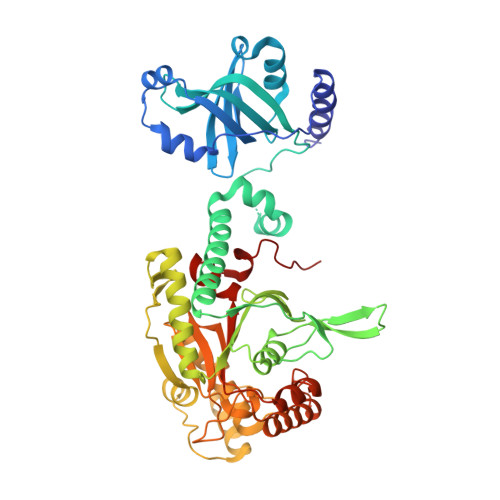Two crystal structures of lysyl-tRNA synthetase from Bacillus stearothermophilus in complex with lysyladenylate-like compounds: insights into the irreversible formation of the enzyme-bound adenylate of L-lysine hydroxamate
Sakurama, H., Takita, T., Mikami, B., Itoh, T., Yasukawa, K., Inouye, K.(2009) J Biochem 145: 555-563
- PubMed: 19174549
- DOI: https://doi.org/10.1093/jb/mvp014
- Primary Citation of Related Structures:
3E9H, 3E9I - PubMed Abstract:
Aminoacyl-tRNA synthetase forms an enzyme-bound intermediate, aminoacyladenylate in the amino-acid activation reaction. This reaction is monitored by measuring the ATP-PPi exchange reason in which [(32)P]PPi is incorporated into ATP. We previously reported that L-lysine hydroxamate completely inhibited the L-lysine-dependent ATP-PPi exchange reaction catalysed by lysyl-tRNA synthetase from Bacillus stearothermophilus (BsLysRS). Several experiments suggested that BsLysRS can adenylate L-lysine hydroxamate, but the enzyme-bound lysyladenylate-like compound does not undergo the nucleophilic attack of PPi. This contrasts with the two reports for seryl-tRNA synthetase (SerRS): (i) L-serine hydroxamate was utilized by yeast SerRS as a substrate in the ATP-PPi exchange; and (ii) a seryladenylate-like compound was formed from L-serine hydroxamate in the crystal structure of Thermus thermophilus SerRS. To gain clues about the mechanistic difference, we have determined the crystal structures of two complexes of BsLysRS with the adenylate of L-lysine hydroxamate and with 5'-O-[N-(L-Lysyl)sulphamoyl] adenosine. The comparisons of the two BsLysRS structures and the above SerRS structure revealed the specific side-chain shift of Glu411 of BsLysRS in the complex with the adenylate of L-lysine hydroxamate. In support of other structural comparisons, the result suggested that Glu411 plays a key role in the arrangement of PPi for the nucleophilic attack.
Organizational Affiliation:
Division of Food Science and Biotechnology, Graduate School of Agriculture, Kyoto University, Kyoto, Japan.
















